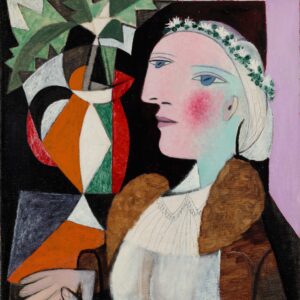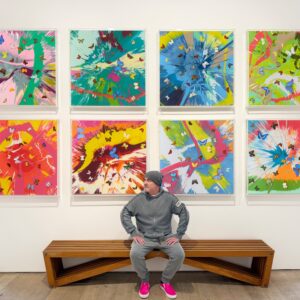FAD met with the founding artists of physical NFT marketplace www.Flipkick.io – Ja Rule, Ben Katz, Lady Jday and Studio Dan.
What’s the story of how Flipkick came about?
Ja Rule: I liked the business model and wanted to be a part of it. Getting people bidding on paintings by great artists. I’m an old-school dude that likes to touch his possessions and a long-time art collector. The Fyre painting captured a moment in time, pop culture and nostalgia but I just wanted to get out of my house. Its creator, Tripp Derrick Barnes, will be showcased down the line.
Over the next 6 months what would you like to see happen with Flipkick?
Ja Rule: It’s already happening; slowly but surely, in the launch and first sales. It’s becoming a serious space alongside the Christies and Sotheby’s of NFTs. I want Flipkick to be a major player in the NFT space; we’ve a lot of artists coming.
There are some amazing pieces on the way. A lot of artists want to be part of Flipkick, and they want to showcase their physical work. The sky is the limit; we could auction an array of things from a classic art piece from a classic artist; to something very new like music. I also love the idea of including music because as a musical artist, we paint our pictures too. I would love to introduce artefacts out of the thought process; imagine Kanye’s new album, with a special cover or set of prints. We made bodies of work as albums. For example, my first album: listen to it from front to back because it all connects and tells a story and a pattern. We lost our way with MP3s and singles, we lost the body of work where the album is the oeuvre. NFTs offer a chance to bring that back, that artistry.

Tripp Derrick Barnes’ Fyre artwork “F*ck This Painting” certainly has a title suggesting a backstory. Ja Rule, how did you feel about the painting what it represented when it was created, and now that it’s been sold for an equivalent of $122,000?
Ja Rule: My feelings about that painting come from a time, a moment when Fyre Festival was going down, the Fyre company was going down, it was something that I had high hopes for. It felt like something truly amazing and the painting was done with that feeling. Feelings of jubilation, happiness, joy, and hopes of great success. When it was up in the office, I just was happy to have it. Then the disaster as we know happened and the painting has been in my house on the wall in my mancave. It’s funny because it’s become part of pop culture even in my home. I’ve got three older kids, 25, 20, 18 soon, and the funny thing is their friends would come by and want to take pictures with it – that motivated me to get it out of the mancave I was going to put it on eBay and let it go. Then I learnt about tokenization and thought about doing something digital with a new twist.
Now that it’s sold, I feel “CLOSURE… exit: Fyre. Enter: ICONN.”
Which NFT communities on Twitter, Discord, Clubhouse are the Flipkick crew most involved with?
Ja Rule: I’m focused on building. I love Clubhouse and what they bring to the table, like how to communicate to learn from each other. I’ll be first to let people know I’m not an expert but learning.
Lady Jday: I’ve been on Clubhouse since yesterday. There are a lot of interesting things – a lot of people are buying,
Ben Katz: It’s interesting to see people’s conversations. I’ve been collecting art for years and have been on Discord and Clubhouse for a bit. I’ve seen that people will claim they’re an authority – I’ve been in this scene a while and take it with a grain of salt
NFT artists are donating to climate with proceeds from sales. Is Flipkick considering an ecological offset?
Ben Katz: It’s always important for artists to give back. Offsetting carbon emissions while minting or purchasing represents a small percentage of the blockchain. With the carbon offset vs. the physical works, the larger issue is whether there’s a charitable aspect. One can denote different charities, For Flipkick we had a timeline too tight to get into launch. Lady Jday and I are collaborating on pieces leading forward to different charities.
Ja Rule: I’ve been talking to a group of all the school principals in the United States. We’ve talked about building the ICONN (Ja Rule’s digital marketplace for content makers) academy and digging deep into that and how to put that together. Ultimately putting the proceeds toward funding the ICONN academy in Queens, New York I’d like to use that school to teach urban youths about technology, film, TV, art, and entrepreneurship.
What are your thoughts on how robots and AI will impact the creative world?
Ben Katz: My background is in engineering, so I’ve looked at some algorithms that analyze art and find they’re very dimensional. If you know how they function using contrast between pixels to gauge variations, it’s hard to implement a real learning algorithm. Art is too subjective so there is unlikely to be generative art that’s better than creations by people.
With robots there is more likelihood in manufacturing, and we’ll see the implications on society, affecting delivery and travel and so on but that’s still years away.

Ben Katz’ Future Friends piece in the Flipkick launch looks like a voxel piece but it’s physical. I could see it in the lobby of a robotics company. What would be your ideal place for the physical work to be on show?
Ben Katz: A robotics/tech company lobby works, or a private collection. Whereas certain pieces would fit a museum. The works can take years to make so NFT is a great way to help people have fractional ownership.
Ja Rule: I’m an art lover and I love the robot head. Do you know the story of the artist and the king? Let me tell you. There was an artist and a king. The king wanted a unique painting, a portrait. The king commissioned it. and paid the artist to do the picture. Three years goes by: no picture. The king is furious with the artist and says “listen you said you’d give me the greatest picture. And you didn’t do it”. The artist then paints the portrait on the spot. The artist replies “I had it done in no time.” The king demands an answer: “I’ve waited 3 years for you to do something you just threw together”. The artist explains “I’ve been thinking about it for the last 3 years”.
How does the NFT aspect work with Flipkick’s physical Flipkick artworks?
Ben Katz: I’d hope the chip could be embedded but the important part is the process. The artwork is sold as an NFT; and then the person who has the digital NFT, they never have to touch the physical art and can sell it
The NFT is sold, and then can be redeemed for the physical work; it’s like an option on futures. There are some issues with using an NFC chip for secure ownership; everything can be hacked and reverse-engineered; that’s why we’re authenticating to the blockchain
Ja Rule: If someone was taking a picture of a piece or recording it/reposting it, there’s nothing to stop that appropriation. It’s the value that people perceive in the holding of the token that’s tied to the piece of artwork. Displaying NFTs in a secure way is not currently possible. In the digital space like in the gaming environment it can be controlled, but when it’s social media – that’s the wild west. Different worlds are tugging at the space, there’s also sports, that’s the classical fine art world, all these different factions, of course, there’s music. Everyone’s tugging at this to claim it as their own space so we can’t put into a pre-existing box. It’s all very much in the testing phase right now. The crypto-currency market didn’t happen overnight; it took years. It’s still very new and it will evolve.
As the creators/visionaries come into the space they make things viable; like the smartmirror, to have NFTs shown in a mirror. Apparently, Bill Gates in his house had this for 15 years at his house in Washington where it’s all smartscreens, and actually has an NFC chip that changes the temperature in the room based on time and mood. Then when Bill Gates couldn’t get his smart tv to turn off – he had to throw a blanket over it! Just be careful it’s listening to you!
The Flipkick site mentions implementing a nearfield communication (NFC) chip inside the artworks, which reference the NFT. Do the current pieces have an NFC chip? If so, is the chip part of the aesthetic or is it clandestine?
Lady Jday: I haven’t thought about that yet, but I may make it part of the piece.
Studio Dan: I will need to explore that. Nothing and nobody get to touch the aesthetic except me!







